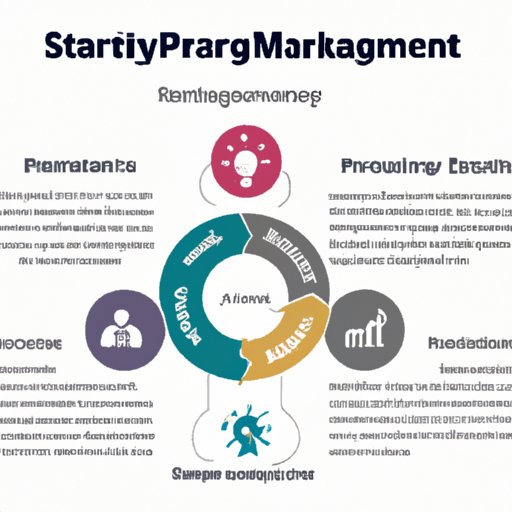Introduction
A marketing strategy is an overall plan for reaching customers and achieving your business goals. It includes researching your target market, setting objectives for your campaigns, identifying the right channels for your message, and measuring and tracking the results of your efforts. By having a clear and well-thought-out marketing strategy in place, you can maximize the success of your business.

Definition of a Marketing Strategy
A marketing strategy is a comprehensive plan that outlines how a company will reach its desired customers by using various marketing tactics. It incorporates all aspects of the business, including product development, pricing, advertising, promotion, sales, customer service, and distribution. The goal of a marketing strategy is to provide direction and focus to the organization so that it can achieve its objectives.
Reasons for Creating a Marketing Strategy
Creating a marketing strategy is essential for any business because it helps to ensure that the company’s resources are being used effectively. It also provides clarity on the company’s goals and objectives, as well as how they will be achieved. A well-crafted marketing strategy allows the business to track progress and make adjustments when necessary. Additionally, it enables the company to stay ahead of its competitors by understanding their strategies and making changes accordingly.
Exploring the Different Components of a Marketing Strategy
When creating a marketing strategy, there are several components that need to be considered. These include the four P’s of marketing (product, price, place, and promotion), identifying your target audience, and developing an effective message.
The Four P’s of Marketing
The four P’s of marketing—product, price, place, and promotion—are the core elements of any successful marketing strategy. Product refers to the goods or services that the company offers. Price is the amount that customers pay for the product. Place is where the product is sold, such as online or in stores. Promotion is how the product is advertised and marketed.
Identifying Your Target Audience
It is important to identify who your target audience is so that you can create a message that resonates with them. This involves researching your potential customers, understanding their needs and wants, and determining how best to reach them. Once you have identified your target audience, you can create a message that speaks directly to them and increases the chances of your marketing efforts being successful.
Developing an Effective Message
Once you have identified your target audience, you need to develop an effective message that resonates with them. This involves crafting a compelling message that conveys the value of your product or service and encourages customers to take action. You should also consider the tone of your message and the language you use, as this can have a big impact on how your message is received.
Creating an Effective Marketing Strategy Step-by-Step
Creating a successful marketing strategy requires planning and execution. Here are the steps to follow:
Establish Goals and Objectives
The first step in creating a marketing strategy is to establish goals and objectives. These should be measurable, achievable, and specific. For example, your goal might be to increase sales by 10% over the next six months. Your objectives could include increasing website visits by 5%, increasing social media followers by 10%, and launching two new products within the same period.
Define Your Budget
Once you have established your goals and objectives, you need to determine how much money you are willing to spend on your marketing efforts. This will help to ensure that you do not overspend and that you are able to measure the return on investment (ROI) of your campaigns.
Choose Your Channels
The next step is to decide which channels you will use to reach your target audience. This could include digital channels such as search engine optimization (SEO), email marketing, and social media, as well as more traditional channels such as print ads, radio, and television.
Track and Measure Results
Finally, you need to track and measure the results of your campaigns. This will allow you to see which channels are working and which ones are not. It will also help you adjust your strategy if necessary.
Analyzing the Benefits of a Well-Crafted Marketing Strategy
A well-crafted marketing strategy can bring numerous benefits to a business. These include:
Increased Brand Awareness
An effective marketing strategy can help to increase brand awareness by getting your message out to a larger audience. This can lead to increased customer loyalty, as well as more referrals and repeat business.
Improved Customer Relationships
By understanding your target audience and creating a message that resonates with them, you can build stronger relationships with your customers. This can lead to improved customer satisfaction and loyalty.
Increased Revenue and Profitability
A successful marketing strategy can help to increase revenue and profitability by driving more traffic to your website and converting leads into customers. This can lead to a higher ROI for your campaigns.

Examining the Impact of Digital Marketing Strategies
Digital marketing strategies have become increasingly popular in recent years. They allow businesses to reach a wider audience and measure the success of their campaigns more easily. Some of the most popular digital marketing strategies include:
Social Media Platforms
Social media platforms such as Facebook, Twitter, and Instagram are powerful tools for reaching potential customers. Companies can use these platforms to share content, engage with customers, and promote their products or services.
Content Marketing
Content marketing involves creating and sharing content such as blog posts, videos, and infographics to attract potential customers. This type of marketing can help to position your business as an authority in your industry and build trust with your customers.
Search Engine Optimization
Search engine optimization (SEO) is the process of optimizing your website and content to appear higher in search engine results pages. This can help to drive more organic traffic to your website, which can lead to more leads and sales.

Identifying the Key Elements of a Successful Marketing Strategy
Creating an effective marketing strategy requires research and planning. Here are some of the key elements of a successful marketing strategy:
Research and Planning
Before you launch any campaigns, you need to conduct research and planning. This includes researching your target audience, understanding their needs and wants, and creating a message that resonates with them. It also involves setting goals and objectives, defining your budget, and choosing the right channels.
Clear Goals and Objectives
Your goals and objectives should be specific, measurable, and achievable. They should also be aligned with your overall business strategy. Knowing what you want to achieve will help to ensure that your campaigns are successful.
Consistency
Consistency is key when it comes to marketing. You should strive to maintain a consistent message across all of your channels and ensure that your messages are up-to-date and relevant.
Measuring and Tracking Results
It is important to track and measure the results of your campaigns so that you can identify which channels are working and which ones are not. This will enable you to adjust your strategy as needed and maximize the success of your efforts.
Conclusion
A marketing strategy is an essential part of any business. It involves researching your target audience, setting goals and objectives, defining your budget, and choosing the right channels for your message. Additionally, it includes tracking and measuring the results of your campaigns to ensure that you are maximizing the success of your efforts. By having a clear and well-thought-out marketing strategy in place, you can increase brand awareness, improve customer relationships, and increase revenue and profitability.
(Note: Is this article not meeting your expectations? Do you have knowledge or insights to share? Unlock new opportunities and expand your reach by joining our authors team. Click Registration to join us and share your expertise with our readers.)
